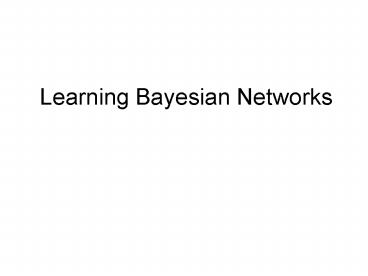Learning Bayesian Networks - PowerPoint PPT Presentation
Title:
Learning Bayesian Networks
Description:
Title: Learning Bayesian Networks: Search Methods and Experimental Results Author: Max Chickering Last modified by: Alan Created Date: 6/30/1995 5:30:58 AM – PowerPoint PPT presentation
Number of Views:121
Avg rating:3.0/5.0
Title: Learning Bayesian Networks
1
Learning Bayesian Networks
2
Dimensions of Learning
Model Bayes net Markov net
Data Complete Incomplete
Structure Known Unknown
Objective Generative Discriminative
3
Learning Bayes netsfrom data
Bayes net(s)
data
X1
X2
Bayes-net learner
X3
X4
X5
X6
X7
prior/expert information
X8
X9
4
From thumbtacks to Bayes nets
Thumbtack problem can be viewed as learning the
probability for a very simple BN
X
heads/tails
5
The next simplest Bayes net
6
The next simplest Bayes net
?
QY
case 1
Y1
case 2
Y2
YN
case N
7
The next simplest Bayes net
"parameter independence"
QY
case 1
Y1
case 2
Y2
YN
case N
8
The next simplest Bayes net
"parameter independence"
QY
case 1
Y1
ß
case 2
Y2
two separate thumbtack-like learning problems
YN
case N
9
A bit more difficult...
- Three probabilities to learn
- qXheads
- qYheadsXheads
- qYheadsXtails
10
A bit more difficult...
QX
QYXheads
QYXtails
heads
X1
Y1
case 1
tails
X2
Y2
case 2
11
A bit more difficult...
QX
QYXheads
QYXtails
X1
Y1
case 1
X2
Y2
case 2
12
A bit more difficult...
?
?
QX
QYXheads
QYXtails
?
X1
Y1
case 1
X2
Y2
case 2
13
A bit more difficult...
QX
QYXheads
QYXtails
X1
Y1
case 1
X2
Y2
case 2
3 separate thumbtack-like problems
14
In general
- Learning probabilities in a Bayes netis
straightforward if - Complete data
- Local distributions from the exponential family
(binomial, Poisson, gamma, ...) - Parameter independence
- Conjugate priors
15
Incomplete data makes parameters dependent
QX
QYXheads
QYXtails
X1
Y1
case 1
X2
Y2
case 2
16
Solution Use EM
- Initialize parameters ignoring missing data
- E step Infer missing values usingcurrent
parameters - M step Estimate parameters using completed data
- Can also use gradient descent
17
Learning Bayes-net structure
Given data, which model is correct?
X
Y
model 1
X
Y
model 2
18
Bayesian approach
Given data, which model is correct? more likely?
X
Y
model 1
Data d
X
Y
model 2
19
Bayesian approachModel averaging
Given data, which model is correct? more likely?
X
Y
model 1
Data d
X
Y
model 2
average predictions
20
Bayesian approachModel selection
Given data, which model is correct? more likely?
X
Y
model 1
Data d
X
Y
model 2
Keep the best model - Explanation -
Understanding - Tractability
21
To score a model,use Bayes theorem
Given data d
model score
"marginal likelihood"
likelihood
22
Thumbtack example
X
heads/tails
conjugate prior
23
More complicated graphs
3 separate thumbtack-like learning problems
X
YXheads
YXtails
24
Model score for adiscrete Bayes net
25
Computation ofmarginal likelihood
- Efficient closed form if
- Local distributions from the exponential family
(binomial, poisson, gamma, ...) - Parameter independence
- Conjugate priors
- No missing data (including no hidden variables)
26
Structure search
- Finding the BN structure with the highest score
among those structures with at most k parents is
NP hard for kgt1 (Chickering, 1995) - Heuristic methods
- Greedy
- Greedy with restarts
- MCMC methods
27
Structure priors
- 1. All possible structures equally likely
- 2. Partial ordering, required / prohibited arcs
- 3. Prior(m) a Similarity(m, prior BN)
28
Parameter priors
- All uniform Beta(1,1)
- Use a prior Bayes net
29
Parameter priors
- Recall the intuition behind the Beta prior for
the thumbtack - The hyperparameters ah and at can be thought of
as imaginary counts from our prior experience,
starting from "pure ignorance" - Equivalent sample size ah at
- The larger the equivalent sample size, the more
confident we are about the long-run fraction
30
Parameter priors
imaginary count for any variable configuration
equivalent sample size
parameter modularity
parameter priors for any Bayes net structure for
X1Xn
31
Combining knowledge data
prior networkequivalent sample size
improved network(s)
data
32
Example College Plans Data (Heckerman et. Al
1997)
- Data on 5 variables that might influence high
school students decision to attend college - Sex Male or Female
- SES Socio economic status (low, lower-middle,
middle, upper-middle, high) - IQ discritized into low, lower middle, upper
middle, high - PE Parental Encouragement (low or high)
- CP College plans (yes or no)
- 128 possible joint configurations
- Heckerman et. al. computed the exact posterior
over all 29,281 possible 5 node DAGs - Except those in which Sex or SAS have parents
and/or CP have children (prior knowledge)
33
(No Transcript)































